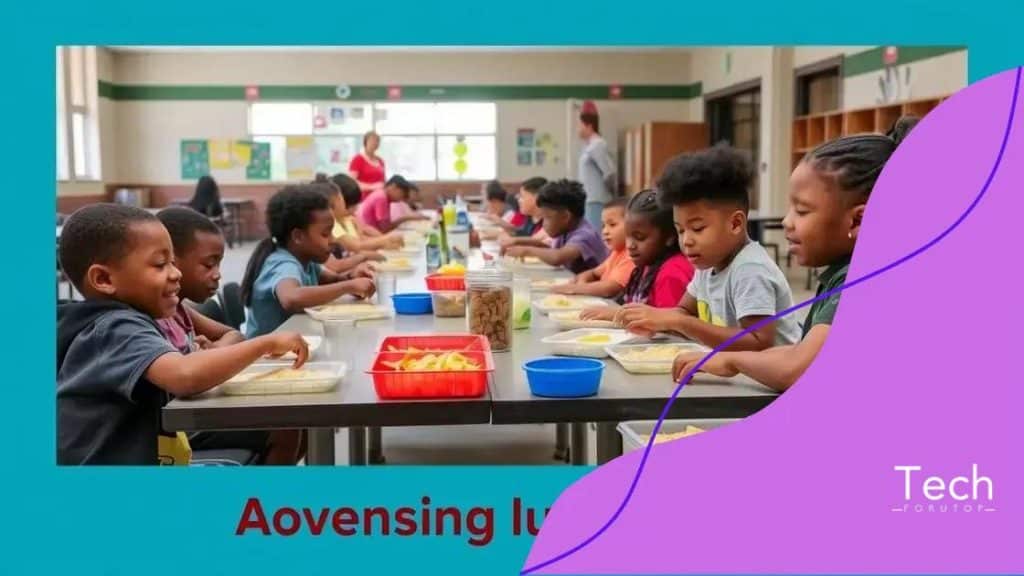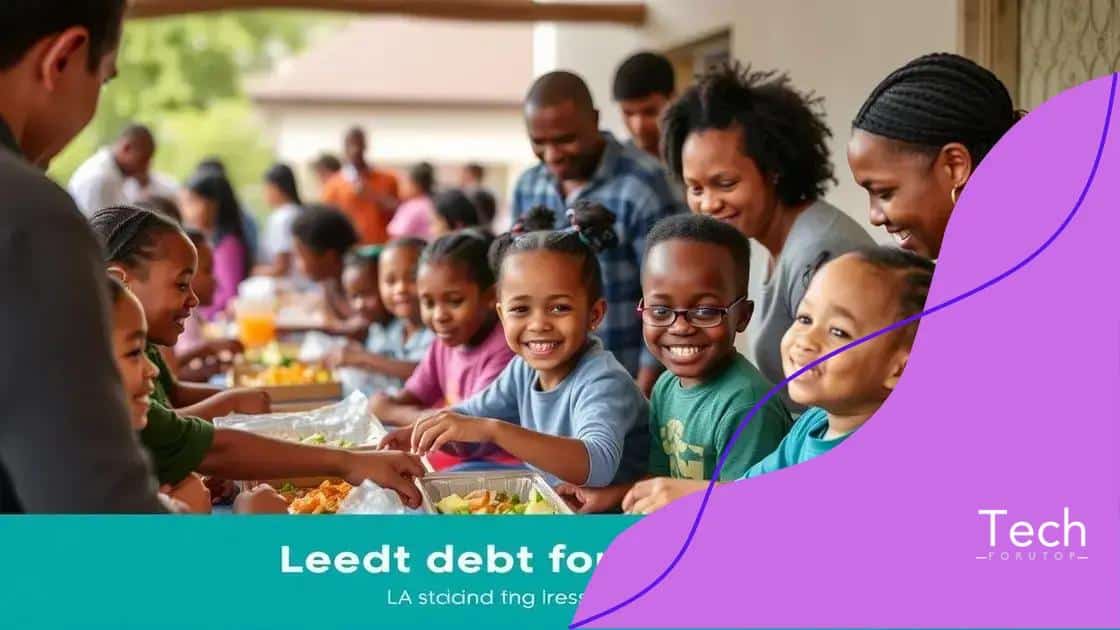Public school lunch debt forgiveness: a community necessity

Public school lunch debt forgiveness is crucial for ensuring every child has access to nutritious meals, eliminating stigma, and fostering a supportive learning environment through community initiatives and collaboration.
Public school lunch debt forgiveness is becoming a focal point in discussions around educational equity. Imagine children missing meals simply because their families are struggling financially. In this article, let’s explore how communities are addressing this pressing issue.
Understanding lunch debt in public schools
Understanding lunch debt in public schools is crucial for grasping the wide impact it has on students and families. This issue often goes unnoticed, yet it affects many children across the country. When families struggle to pay for school meals, kids can face stigma and hunger.
What is Lunch Debt?
Lunch debt occurs when students cannot pay for their meals at school. This can happen for various reasons, including low income or unexpected financial challenges. Sometimes, parents are unaware of programs that help with meal costs.
The consequences of lunch debt can be severe. When debts accumulate, schools may deny meals to students. This leads to social isolation and stress for many children. Victims of lunch debt often feel embarrassed or ashamed in front of their peers.
Causes of Lunch Debt
- Low family income
- Lack of awareness about assistance programs
- Unexpected financial hardships
While some schools work hard to support their students, financial restraints often limit their options. Understanding the barriers is the first step to finding solutions. Raising awareness about this very real issue can help communities come together for support.
Impact on Students
The impact of lunch debt on students is profound. When children go without food, their ability to concentrate diminishes. Hungry students struggle to focus in class, negatively impacting their academic performance. Additionally, they may miss out on social experiences during lunch, further deepening feelings of isolation.
Addressing lunch debt can significantly improve the school environment. By implementing programs targeted at reducing or eliminating this debt, schools can ensure that all students have access to nutritious meals. It is heartening to see communities working together to combat this issue.
Impact of lunch debt on students and families
The impact of lunch debt on students and families is significant and often overlooked. Many children face challenges that extend beyond financial struggles when it comes to school meals. The repercussions can affect their emotional well-being and academic success.
Emotional and Social Effects
When students cannot pay for lunch, they may experience feelings of shame or embarrassment. This can lead to social isolation from their peers. Many children dread lunchtime, not just because of hunger, but due to the stigma associated with lunch debt. They might feel less accepted among their friends, leading to lower self-esteem.
- Increased anxiety about mealtime
- Isolation during lunch breaks
- Stigma associated with financial struggles
Additionally, families dealing with lunch debt can feel overwhelmed. Parents may face stress as they try to provide for their children while also managing bills and living expenses. This often results in a cycle of anxiety for everyone involved.
Academic Consequences
The effects of lunch debt extend into the classroom. When children are hungry, their ability to focus on learning diminishes. They may struggle with assignments and fail to participate in class discussions, further hindering their educational progress.
Research indicates that hungry students often get lower grades and test scores compared to their peers who receive regular meals. Moreover, absences can increase, as children may not want to face the anxiety related to their lunch debts.
Addressing the impact of lunch debt requires community effort. Schools, families, and local organizations can come together to create solutions that alleviate this burden. Building a supportive environment helps everyone feel valued and included.
Community initiatives for debt forgiveness

Community initiatives for debt forgiveness are vital in addressing the growing issue of lunch debt in public schools. Many neighborhoods have come together to form programs that aim to support families struggling to pay for school meals. These initiatives help remove the financial burden, ensuring that every child has access to nutritious food.
Types of Community Initiatives
There are many ways that communities work together to provide solutions. Some schools partner with local organizations to create fundraising events. These events raise money specifically to pay off a student’s lunch debt. In addition, some communities set up meal donation programs to help families in need.
- Fundraising events at schools
- Meal donation drives
- Local business sponsorships
Many schools implement programs to help inform families about available resources. Schools may hold informational meetings or send home flyers that list options for meal assistance. This awareness can make a significant difference in reducing lunch debt.
Collaborations with Local Businesses
Local businesses play an essential role in supporting these initiatives. Many companies provide sponsorships or donate supplies to help alleviate the burden of lunch debt. By collaborating with schools, businesses can show their commitment to the community, creating a stronger bond between families and local enterprises.
Community members can also organize volunteering efforts, where parents and students come together to prepare and serve meals. This involvement fosters a sense of togetherness, ensuring all families feel valued and supported.
The success of community initiatives depends on active participation and collaboration. When everyone works together, it creates a stronger environment for children and their families.
Case studies of successful forgiveness programs
Case studies of successful forgiveness programs illustrate how communities are effectively addressing lunch debt in schools. These stories provide valuable insights into what works and how they can be replicated in other areas. Understanding these examples can inspire others to take action.
Example 1: Local School District Initiative
In a nearby school district, the local government collaborated with non-profit organizations to eliminate lunch debt for all students. They launched a campaign called “Eat Well, Learn Well,” which focused on raising funds through community events. This effort allowed them to pay off debts completely in just one school year.
- Weekly community potlucks to raise money
- Awareness programs in local schools
- Partnerships with local businesses for sponsorship
Results showed that students were happier and more engaged. Academic performance improved as students could focus better in class without worrying about their lunch debt.
Example 2: Statewide Program
A statewide program implemented in California tackled lunch debt through legislation. The state provided funding directly to schools, ensuring that every student received free lunches regardless of their financial situation. This policy dramatically reduced the stigma surrounding lunch debt and created a more inclusive environment in schools.
This state initiative produced notable outcomes, including higher attendance rates and increased participation in meal programs. Students felt more supported, knowing that their meals were guaranteed.
These case studies highlight the importance of community involvement and policy support in reducing lunch debt. They demonstrate that working together can create positive changes for students and families.
Future of lunch programs and debt elimination
The future of lunch programs and debt elimination in schools is looking promising as communities become more aware of the issues surrounding lunch debt. Increasing support for initiatives and programs emphasizes the importance of providing nutritious meals for all students. As more communities take action, we can expect positive changes ahead.
Innovative Solutions
Schools are exploring innovative solutions to improve meal programs. Some districts are implementing universal free lunch policies, ensuring that every student has access to meals regardless of their financial situation. This approach not only eliminates lunch debt but also reduces the stigma that comes with relying on free meals.
- Universal free lunch programs
- Partnership with local farms for fresh ingredients
- Mobile apps to track meal participation
Technology is also playing a significant role in advancing these programs. For example, digital payment systems simplify the transaction process for parents and help schools manage funds more effectively. With such advancements, meal programs can refine their approaches to better serve students.
Community Engagement
Community engagement will be crucial in shaping the future of lunch programs. Parents, teachers, and local organizations must collaborate to find practical solutions for debt elimination. By working together, they can raise awareness about existing resources and create new opportunities for funding through events and partnerships.
Additionally, educational campaigns can inform families about programs that assist with free and reduced-price meals. By spreading this knowledge, families will know their options, helping to reduce lunch debt significantly.
The path towards effective lunch programs and the complete elimination of lunch debt involves a commitment to ongoing improvement and innovation. With the combined efforts of the school districts, communities, and policymakers, we can ensure that every child has access to healthy meals.
FAQ – Questions about lunch debt forgiveness programs
What is lunch debt in public schools?
Lunch debt refers to the unpaid amounts owed by students who cannot afford to pay for their school meals. This often leads to stigma and financial strain on families.
How can communities help with lunch debt forgiveness?
Communities can organize fundraising events, partner with local businesses, and create awareness campaigns to support families in need and eliminate lunch debt.
What are the benefits of eliminating lunch debt?
Eliminating lunch debt ensures that all students have access to nutritious meals, promotes a positive school environment, and reduces social stigma.
Are there successful examples of lunch debt forgiveness programs?
Yes, many schools have implemented successful programs through community collaboration and state funding that eliminate lunch debt and provide free meals for all students.





